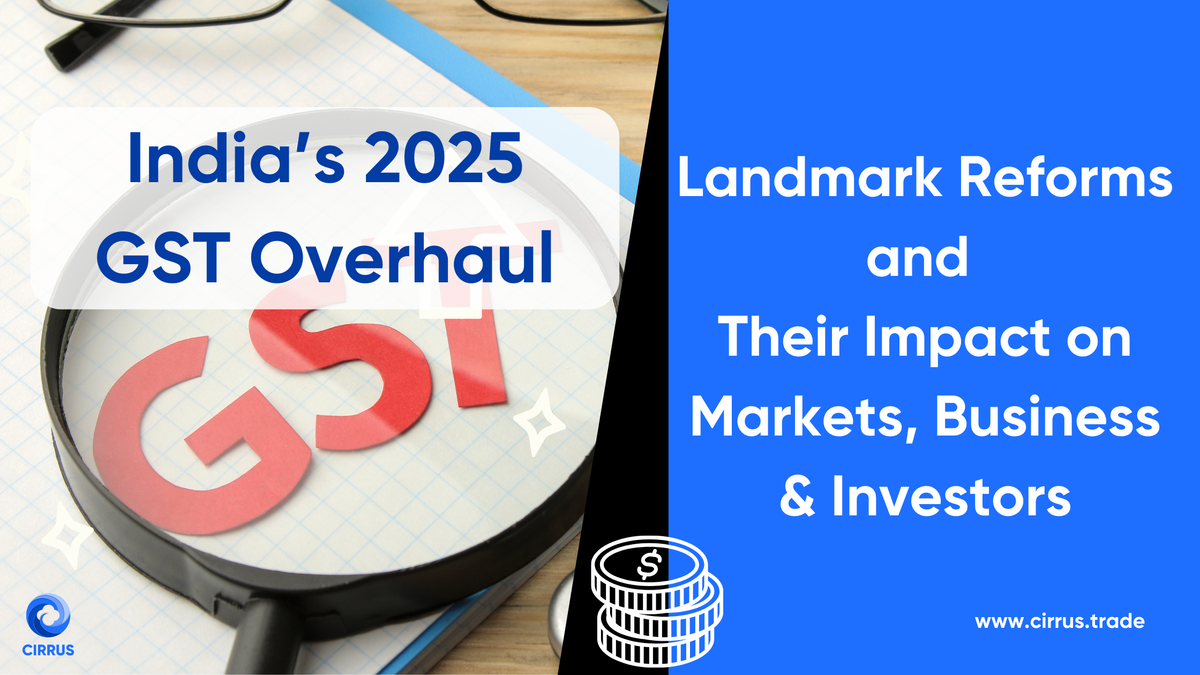India’s 2025 GST Overhaul: Landmark Reforms and Their Impact on Markets, Business & Investors

Blog by Cirrus.Trade

Introduction
In a historic move this August, India’s government announced an ambitious revamp of the Goods and Services Tax (GST) regime, aimed at streamlining tax rates, cutting the tax burden for consumers, and reviving critical sectors before the festival season. The reforms, described by Prime Minister Narendra Modi as a “Diwali gift,” are slated to roll out after final approval by the GST Council in September, and are expected to reshape spending, business strategies, and market behaviour across the nation.
The New GST Structure: Simplifying the Tax Landscape
The reforms propose a hammer blow to the complexity of the former system, focusing on three key elements:
- Rationalised Slabs: Most items in the 12% and 28% categories will be shifted to either 5% (essentials) or 18% (standard) GST, simplifying the tax structure from four rates (5%, 12%, 18%, 28%) down to just two principal rates. Sin goods and luxury items (e.g., tobacco, high-end vehicles) get their own 40% slab.
- Cheaper Essentials: Roughly 99% of items in the 12% category, including packaged food, medicines, personal care items, electronics, garments, and footwear, are expected to see GST drop to 5%.
- Big-Ticket Relief: Almost 90% of items formerly at 28% GST, such as washing machines, air conditioners, cement, small cars, and two-wheelers, will move to the 18% slab.
Luxury and sin goods will remain outside this structure, taxed at 40% to preserve crucial revenue and support progressive policy goals.
Policy Intent and Official Announcements
During his Independence Day address, Prime Minister Modi directly linked these reforms to the government’s broader consumption and growth agenda. He promised, “I am going to give a great gift this Diwali… we are set to introduce a ‘next-generation GST reform’,” confirming that a detailed proposal is now with the GST Council for final sign-off before Diwali. Finance Ministry press statements have reiterated the goals: simpler compliance for business, lower rates and higher affordability for consumers, and a boost for MSMEs and the middle class.
Major news outlets and government officials highlight that these changes come after extensive consultation between the Centre, states, and sectoral groups, aiming to “reduce classification disputes,” “support essential goods,” and enhance “ease of doing business” for all sizes of enterprises.
Sectoral Impact: How Reforms Affect India’s Economy
1. For Consumers
- Everyday goods, foodstuffs, toiletries, shoes, garments, and medical supplies will become more affordable, particularly benefitting middle and lower-income families.
2. Automobiles & Consumer Durables
- Slashing GST on cars, two-wheelers, washing machines, and air conditioners from 28% to 18% will likely generate price reductions at the consumer end, prompting renewed demand after sluggish sales and lifting India’s manufacturing and retail ecosystem.
3. FMCG and Retail
- Large fast-moving consumer goods (FMCG) firms stand to gain from lower GSTs on packaged foods and personal care, potentially driving volume growth, competitive pricing, and increased market penetration.
4. Manufacturing, Infrastructure & Real Estate
- Construction and housing sectors benefit as cement and building materials shift to 18% GST, streamlining procurement, lowering costs, and enabling new projects.
5. Markets and Investors
- Markets have already rallied in Auto, FMCG, Durables, and Building Materials. Investors expect earnings upgrades and fresh sectoral rotation into GST winners. Stock markets reacted quickly to the reform announcement, particularly with gains in sectors poised to benefit directly from GST cuts
Ongoing Dialogue and Implementation
While the overhaul enjoys broad support, some caution remains around “luxury” and “sin” taxes, which stay at 40%, and the precise timing and modalities of the final GST Council decisions. The Council is scheduled to meet in September for a last round of deliberations, with implementation planned before Diwali 2025.
What Cirrus Users and Market Professionals Should Monitor
Though the GST reforms do not directly alter brokerage levies, exchange fees, or financial transaction GST, several indirect implications matter for Cirrus’s trading and finance-savvy community:
- Sector volatility: Active traders may find new short- and medium-term opportunities in sectors like auto, FMCG, durables, and infra, riding the momentum of the “tax rationalisation” trade.
- Earnings upgrades: Analysts expect improved corporate results and valuation recalibrations in GST-impacted sectors, creating fresh trading opportunities for retail and professional investors.
- SMEs & Compliance: For business owners, a cleaner GST structure means fewer classification disputes, easier filings, and potential savings on everyday procurement.
Conclusion
India’s “GST 2.0” reforms represent a watershed moment, targeting affordability, simplicity, and sectoral growth. As official sources and major broadcasters confirm, this policy will touch virtually every segment of the Indian economy, from the shop floor to the trading desk, and across rural and urban India alike. Market participants would do well to watch the Council’s final notifications and position themselves to take advantage of the evolving landscape.
Disclaimer: This blog is for informational and educational purposes only. It draws on government press releases, official GST Council communications, and reporting by leading news channels. For specific policy or investment decisions, please refer to formal GST Council publications and seek advice from registered professionals.
Key sources:






